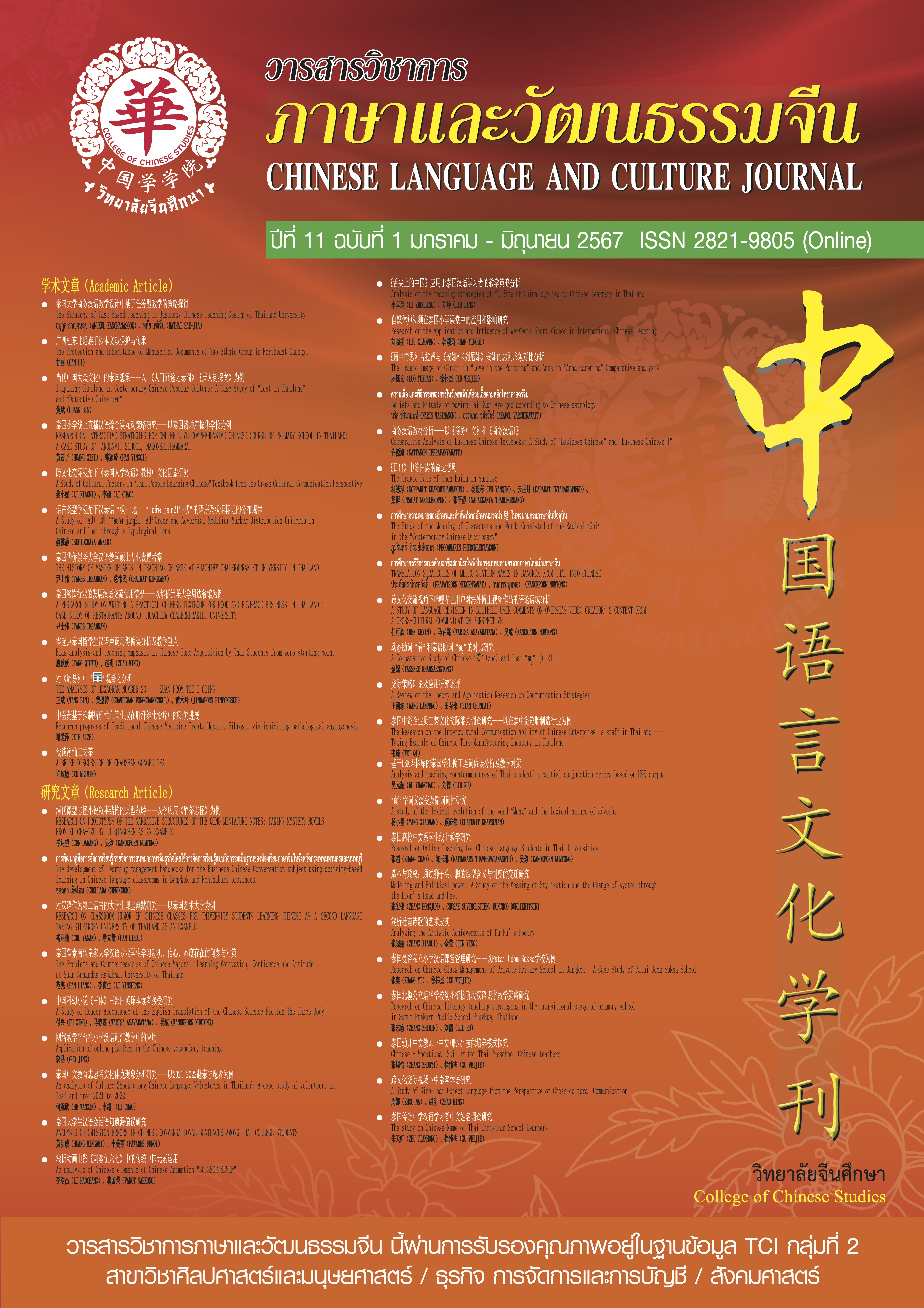A Comparative Study of Chinese“着”(zhe) and Thai“อยู่”[juː21]
Keywords:
Chinese-Thai particles, the dynamic particle "着", the particle "อยู่", comparisonAbstract
"Dynamic particles" are a type of word widely used in modern Chinese. Due to their complex grammatical meanings and features, Thai learners of Chinese are prone to errors when learning these "dynamic particles." In order for Thai students to better learn Chinese, they must truly grasp the grammatical features and usage of these "dynamic particles." Therefore, it is crucial to research and understand their background and usage rules. A comparative study and analysis of the Chinese dynamic particle "着" and the Thai dynamic particle "อยู่" reveal similarities and differences in syntactic position, grammatical features, and functions. During the research process, relevant Thai and Chinese language data were collected, providing examples and explanations to analyze and identify similarities and differences between the two languages, thus offering insights for future Chinese language teaching and development. Despite the many similarities between these two languages, there are also some important differences. One significant difference is that the Chinese dynamic particle "着" generally combines with verbs, especially in the presence of objects, where the dynamic particle "着" should be placed after the verb and before the object; whereas the Thai dynamic particle "อยู่" generally follows the verb, forming a verb-noun phrase.
References
[泰] 阿玛拉·巴悉拉塔信,姜泽满.泰语词类划分的主要原则.[J].百色学院
学报.2014,27(06):40-48.DOI:10.16726/j.cnki.bsxb.2014.06.008.
[泰] 维金·帕努蓬.泰语的结构:语法系统.[M].曼谷:蓝康恒大学出版社,1979.
[泰] 乌巴吉·辛拉巴讪.泰语法则.[M].曼谷:泰瓦塔纳帕尼奇出版社,1937.
[泰] 卡柴·童姥.泰语语法.[M].曼谷:消息收集出版社,1966.
[泰] 瓦利·奇姆派布恩.泰语助动词.[D].曼谷:朱拉隆功大学,1966.
https://cuir.car.chula.ac.th/handle/123456789/40372
[泰] 班主·潘灭他.泰语形式.[M].曼谷:蓝康恒大学出版社,2001.
[泰] 娜瓦婉·潘图梅塔.泰语语法.[M].曼谷:荣格桑印刷出版社,1982.
陈晨.留学生汉语体标记习得的实证研究.[D].中央民族大学,2010.
黎锦熙.新著国语文法.[M].北京:商务印书馆,1924.
吕叔湘.中国文法要略.[M].北京:商务印书馆,1947 .
韩朝婷.现代汉语将来时标记研究.[D].苏州大学,2013.
龙果夫.现代汉语语法研究.[M].北京:中华书局.1958.
石毓智.论现代汉语的“体”范畴.[J].中国社会科学.1992,(06):183-201.197
龚千炎.汉语的时相时制时态.[M].北京:商务印书馆.1995.
戴耀晶.现代汉语时体系统研究.[J].汉语学习.1997,(02):55.
黄伯荣,廖序东.现代汉语:增订本.下册.[M].5版.北京:高等教育出版社,2011.6.28.
吕叔湘.现代汉语八百词.[M].北京:商务印书馆,1980.
朱德熙.语法讲义.[M].北京:商务印书馆,2007.68.
徐通锵.语言论-语义型语言的结构原理和研究方法.[M].长春:东北师范大学出版社,1997.497-508.
卢英顺.关于“了1”使用情况的考察.[J].安徽师大学报(哲学社会科学版).1994,(02):194-200.194.
戴耀晶.现代汉语表示持续体的“着”的语义分析.[J].语言教学与研究.1991,(02):92-106.92.
房玉清.动态助词“了”“着”“过”的语义特征及其用法比较.[J].汉语学习.1992,(01):14-20.15.
刘月华.动态助词“过2过1了1”用法比较.[J].语文研究.1988,(01):6-16.6.
孙德坤.外国学生现代汉语“了·le”的习得过程初步分析.[J].语言教学与研究.1993,(02):65-75.65.
陈作胜.汉语老挝语动态助词对比研究.[D].广西民族大学,2013.5.
Downloads
Published
How to Cite
Issue
Section
License
Copyright (c) 2024 Chinese Language and Culture Journal

This work is licensed under a Creative Commons Attribution-NonCommercial-NoDerivatives 4.0 International License.
บทความที่ได้รับการตีพิมพ์เป็นลิขสิทธิ์ของวารสารภาษาและวัฒนธรรมจีน มหาวิทยาลัยหัวเฉียวเฉลิมพระเกียรติ
บทความใน “วารสารวิชาการภาษาและวัฒนธรรมจีน” เป็นทรรศนะของผู้เขียนโดยเฉพาะ กองบรรณาธิการไม่มีส่วนในความคิดเห็นในข้อเขียนเหล่านั้น




